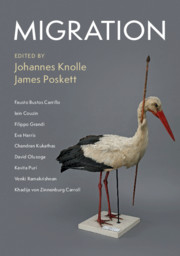Book contents
- Migration
- The Darwin College Lectures
- Migration
- Copyright page
- Contents
- Figures
- Notes on Contributors
- Acknowledgements
- Introduction
- 1 Black and British Migration
- 2 Immigration and Freedom
- 3 Art and Migration
- 4 Refugees and Migration
- 5 Migration of Disease
- 6 The Partition of India and Migration
- 7 Migration in Science
- 8 Animal Migration
- Index
8 - Animal Migration
Published online by Cambridge University Press: 25 March 2020
- Migration
- The Darwin College Lectures
- Migration
- Copyright page
- Contents
- Figures
- Notes on Contributors
- Acknowledgements
- Introduction
- 1 Black and British Migration
- 2 Immigration and Freedom
- 3 Art and Migration
- 4 Refugees and Migration
- 5 Migration of Disease
- 6 The Partition of India and Migration
- 7 Migration in Science
- 8 Animal Migration
- Index
Summary
Ever since I was a kid, I’ve been fascinated by the type of footage you see of silverside fish schooling near a coral reef and starlings forming these large murmurations in the sky. And what’s really remarkable, to me as a biologist, is how little we know about both how and why unrelated organisms like this coordinate these remarkable collective patterns. And yet collective behaviour is not only all around us – it’s within us. Our bodies, of course, are a collective of cells. At the Max Planck Institute for Ornithology, we really try to understand the principles of collective behaviour across scales of organisation in biological systems. In this chapter, I’m going to set out some of the latest research on collective animal migration: how organisms come together and integrate their minds to solve very complex problems during migration across the globe.
Information
- Type
- Chapter
- Information
- Migration , pp. 166 - 180Publisher: Cambridge University PressPrint publication year: 2020
